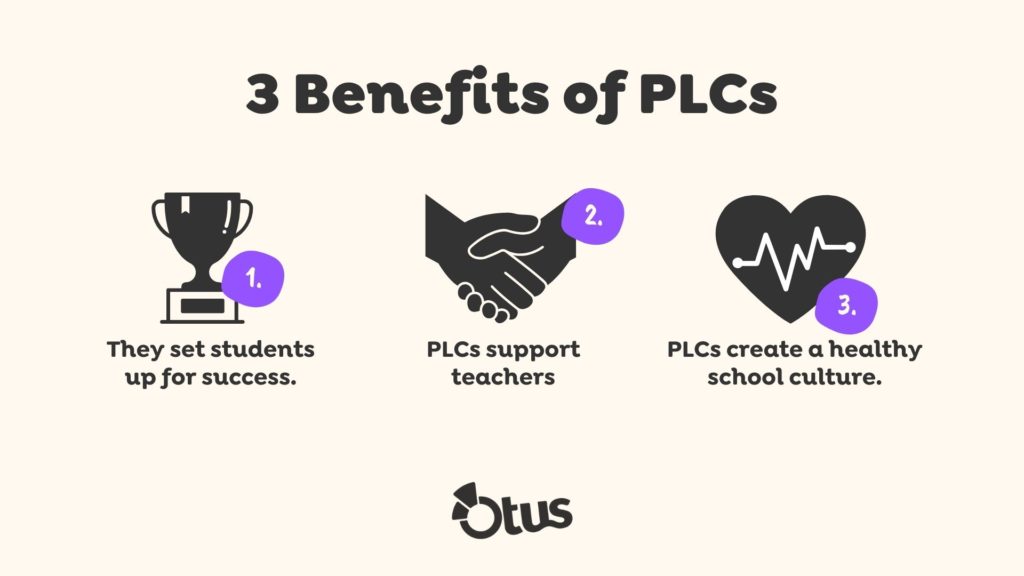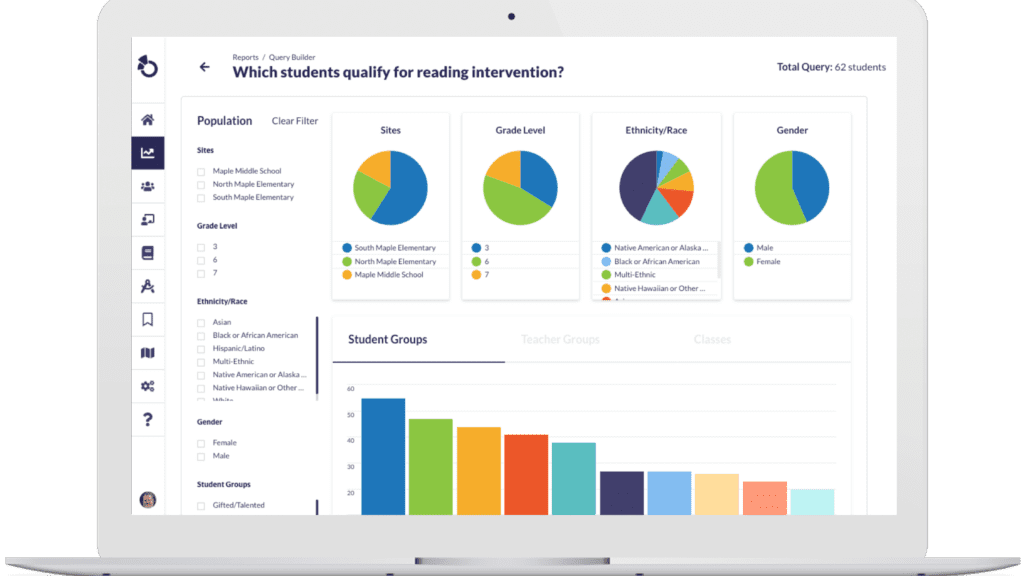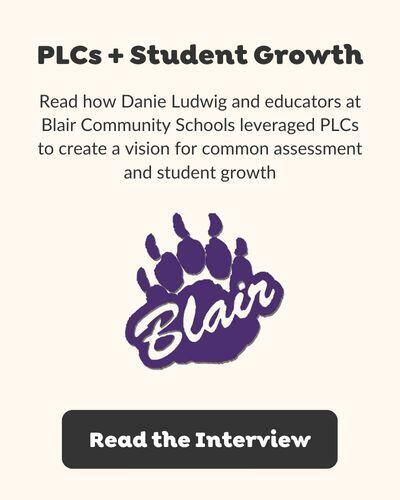The Educator's Guide to Professional Learning Communities (PLCs)
Welcome to the educator’s guide to professional learning communities, also known as PLCs.
Whether you’re starting a professional learning community at your school or considering joining a professional learning community, you’re in the right place! This guide will serve as a great introduction to best practices, benefits, and more for professional learning communities.
What is a Professional Learning Community?
A Professional Learning Community, or PLC, is a process of determining new pathways for student success through the collaboration of teachers and other stakeholders. In the traditional approach to implementing changes in districts or schools, a top-down, authoritarian decision determines every aspect of the process, from instruction to intervention. In a PLC, the approach is collaborative, involving teachers working alongside other teachers and administrators. Sometimes even families and students are also part of the process to determine how they can best work together to help students succeed.
While Professional Learning Communities can vary from school to school, they always share a few key characteristics, found in the name itself: professionals who build a community for the sake of learning. While this may seem simplistic, looking at each of these words individually can help with the holistic view.
First, the PLC must be made up of professionals. On one level, this means educational experts who know their craft. On a deeper level, this means teachers and administrators who understand that the most important goal is creating a common vision to increase student achievement and that getting to this goal will involve a mindset around healthy dialogue and occasional disagreement, resulting in what is best for the students and the school community.
Second, the PLC must focus on learning as a key value. Significantly, they see learning not just for students but for staff as well. Moreover, they see true learning as an ongoing process that involves collaboration, dialogue, and reflection.
Third, and perhaps most importantly, PLCs see themselves as a community of people working together for a common good. Simply put, PLCs are not teachers against administrators or department against department, but one staff coming together in a variety of ways to build a healthy culture that drives student growth and staff alignment.
What is the Purpose of a PLC?
The purpose of a Professional Learning Community is to increase student achievement through data-driven analysis and strategy. However, there are also several complementary purposes that support the foundational goal of student achievement.
Effective PLCs emphasize care for teachers as an equally important goal. When teachers are cared for through professional development and supported in their need to collaborate and support one another, they are better able to support student learning needs and goals.
Additionally, PLCs create a healthy school culture where staff is aligned and understands their school’s mission because they work collaboratively to achieve this vision. That passion for the school’s mission, always created around student growth and learning, often trickles down to students as they, too, grow passionate about learning and the school’s mission.
How to Start a PLC in Your School

Establish a shared vision and common goal for the PLC.
What do they want to accomplish with this time? The end result of a PLC will always, in some way, focus on an increase in student learning and mastery. Common goals for professional learning communities are vast. They can include broad objectives, like creating a new school mission, or student growth-focused goals, like developing a new curriculum to address where students need support, then developing a response to intervention. The size and scope of the PLC doesn’t matter as long as the plan is clear at the start. Without a clear vision and end goal, the community cannot accomplish anything of significance and will flounder.
For an effective PLC, create a culture of collaboration.
This involves choosing participants wisely and ensuring those chosen are ready to embrace the challenge of the learning community’s task. Once the goal for the community time is established, the participants must agree to work together on a regular basis through shared ideas and respectful dialogue until the goal of the community is accomplished.
Support PLC participants in their development.
These needs will vary depending on the community’s end goal. However, it always requires the buy-in of administrators, as this type of development requires extra time and may require money. Administrators often find, though, that this proves to be a wise investment in the long run. Equipping teachers and staff to continually grow in their subject and craft allows professional learning communities to thrive, which only strengthens a school and its students.
Focus your PLC on being data-driven.
Communities that rely on intuition and personal opinions rarely succeed in completing their objectives. The professional learning communities that implement a variety of student data and research to drive their choices, on the other hand, regularly find a clear path forward. They are able to be truly strategic with their decision-making processes and are able to confidently recommend effective solutions to the problems they are working to address in their communities.
This is also important when it comes to support for the PLC. When PLCs can present hard data as a metric for success, they receive more support from administration and teachers.
Allow regular dialogue and reflection among PLC participants.
As mentioned previously, participants in a learning community must act and speak collaboratively, understanding that only through discussing different opinions will they find successful solutions. It is essential that a learning community takes time to reflect both after meetings and after a decision is implemented. Is the decision achieving the desired results? Why or why not? How can the decision be adapted to achieve even greater results? These are the types of questions that a learning community must ask if they are to see lasting results.
Professional Learning Community (PLC) Best Practices
The PLC must commit to a regular meeting time.
Depending on the scope and objective of the PLC, this may be a quick stand-up each afternoon to discuss a student’s goals or a once-a-month meeting to move a new curriculum plan forward. Consistency is more important than frequency.
Everyone must commit to attending every PLC meeting.
It is almost impossible to move objectives forward without a high level of commitment. PLCs can waste too much time recapping previous meetings or moving deadlines back to allow absent members to catch up on necessary tasks.
A strong PLC needs a strong facilitator.
The facilitator should have experience leading group discussions and reflections. They should also be confident in driving discussions forward and remain focused on data and results, nipping any off-topic conversations in the bud.
All data used in PLC meetings must be relevant and up to date.
Without real-time data and analytics, it is difficult to learn from what has been done. More importantly, it is almost impossible to analyze if decisions made by the committee are working. No one involved in a professional learning community wants to make a decision that falls flat. Real-time student data helps learning communities evaluate decisions and pivot as necessary so they can make real, lasting changes in students’ best interests.
How Otus Makes Running a PLC Easy
Otus is a comprehensive and collaborative platform for K-12 schools that centralizes assessment, data warehousing, progress monitoring, and more. With Otus, teachers have access to organized, real-time student data. So instead of spending time aggregating data, they can focus time and energy on the PLC process. Along with organized student growth data, many other Otus features support PLCs. In Otus, you can:
- Build engaging lessons.
- Create formative assessments aligned to learning intentions and standards.
- Share anything created in Otus with colleagues (assessments, lessons, resources, and more).
- Create student groups directly from assessment data.
- Assign interventions or enrichment resources to those student groups.
- View a comprehensive student profile with student reports, information, and more.
These features and more allow for collaboration and transparency in your PLC. Interested in learning more about how Otus can support your PLCs? Request a demo now..
3 Benefits of Professional Learning Communities

1. They set students up for success.
The purpose of a PLC is to increase student learning and growth. PLCs are data-based and action-oriented through strategic intervention, so they are highly effective for identifying the core roadblocks preventing student learning and the steps the student needs to take to move forward.
2. Professional learning communities support teachers.
Again, the most effective PLCs are the ones that are not only focused on student achievement but teachers as learners. They support a teacher’s growth and development and provide additional time to ensure a teacher is highly qualified.
Moreover, PLCs provide teachers with a safe, healthy community to process instructional choices and use data to drive strategic solutions that work.
3. PLCs create a healthy school culture.
A school’s culture is not only determined by administrators; students and teachers also play a role. You cannot have a healthy school culture if one of these groups is struggling. When both students and teachers are doing well, that successful energy contributes to a positive school culture. Thriving students and teachers mean a thriving school culture.
What Administrators Need to Know About PLCs
It is imperative that administrators implementing a professional learning community help teachers understand the why behind the PLC. The biggest implication is that an effective PLC will change the instructional approach of a teacher.
Many teachers, especially those unfamiliar with PLCs or those not given adequate support, may feel threatened, intimidated, or underappreciated in this process. A clumsy PLC will make a teacher feel forced into the change, which will only backfire in the long run.
An effective PLC leader will help teachers feel supported, encouraged, and appreciated. Then, teachers will feel motivated and inspired to change instructional approaches based on data-driven recommendations and collaborative insights.
Teachers who are not given the support needed to carry a professional learning community forward will feel overwhelmed and overworked. It is essential for administrators to provide teachers in their PLC additional time and professional development support to ensure they have what they need to succeed.
Finally, administrators must understand their staff’s history with PLCs and other educational initiatives. Too many teachers have been introduced to many ineffective “new strategies.” This can lead to skepticism, a lack of buy-in, or even downright resentment toward the PLC. It is an administrator’s priority to help teachers understand the benefits of a PLC.
What Teachers Need to Know About PLCs
Too often teachers, are given too many objectives without enough support. Professional learning communities, when done well, are fantastic solutions to meeting objectives with increased support.
Teachers should know that PLCs offer an outlet for creative brainstorming and problem solving for any classroom problem or challenge they face.
This includes:
- Academic Intervention Plans
- At-Risk Identification
- Behavior Modification Plans
- Classroom Observations
- Common Assessments
- Graduation Pathway Plans
- RTI Plans
- …and so much more!
Professional learning communities can exist for grade levels, subject materials, or even just one student in need of extra support.
Additionally, teachers should know they don’t need to wait for administrators to get the ball rolling on PLCs. Often, successful PLCs are started by teachers ready to take the initiative to find creative solutions to problems they are facing in their classrooms.
In Conclusion
Supported teachers support other teachers and their students! Professional Learning Communities offer support for teachers, increase support and achievement for students, and promote a healthy, thriving culture for schools. The best part? They are flexible and easy to adapt based on the school or students’ needs.
Request a demo!
See exactly how Otus can help your school accelerate student growth and improve student outcomes – all while saving educators time.






